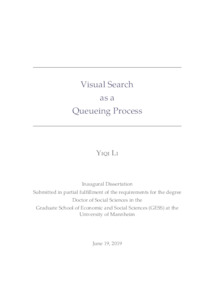|
Visual search as a queueing process
Li, Yiqi
![[img]](https://madoc.bib.uni-mannheim.de/53040/1.hassmallThumbnailVersion/Dissertaion_Visual_Search_as_a%20_Queueing_Process_Yiqi_Li_print.pdf)  Vorschau |
|
PDF
Dissertaion_Visual_Search_as_a _Queueing_Process_Yiqi_Li_print.pdf
- Veröffentlichte Version
Download (7MB)
|
|
URL:
|
https://madoc.bib.uni-mannheim.de/53040
|
|
URN:
|
urn:nbn:de:bsz:180-madoc-530406
|
|
Dokumenttyp:
|
Dissertation
|
|
Erscheinungsjahr:
|
2019
|
|
Ort der Veröffentlichung:
|
Mannheim
|
|
Hochschule:
|
Universität Mannheim
|
|
Gutachter:
|
Erdfelder, Edgar
|
|
Datum der mündl. Prüfung:
|
26 August 2019
|
|
Sprache der Veröffentlichung:
|
Englisch
|
|
Einrichtung:
|
Fakultät für Sozialwissenschaften > Kognitive Psychologie (Seniorprofessur) (Erdfelder 2019-)
Außerfakultäre Einrichtungen > GESS - CDSS (SOWI)
|
|
Fachgebiet:
|
150 Psychologie
300 Sozialwissenschaften, Soziologie, Anthropologie
510 Mathematik
|
|
Freie Schlagwörter (Englisch):
|
visual search , queueing models , serial/parallel processing , RT distribution modeling , error modeling , stochastic modeling of cognitive processes , Monte Carlo simulation based parameter estimation
|
|
Abstract:
|
A mathematical model accounting for both accuracy and response time (RT) data in standard visual search experiments on a distributional level has been developed. The model implements the conceptualization of Moore and Wolfe(2001) of a hybrid model, in which visual stimuli are selected by attention one after another and then identified in parallel. For the modeling of RT data on a distributional level, a finite-time queueing model with exponentially distributed interarrival times and service times, c parallel servers and a finite customer source is specified. It characterizes both the serial and parallel aspects of the visual search process by modeling it as a queueing system where stimuli enter serially and are processed in parallel at multiple servers. For the modeling of accuracy data, the queueing model is extended by integrating a mechanism that produces incorrect system responses. It differentiates between genuine processing errors and decision errors due to incomplete search. The observer is assumed to adapt a discrimination criterion for stimulus identification and a termination rule of search that both depend on set size to optimize search efficiency. The termination rule derived based on optimal foraging theory regulates the termination of the queueing process. Embedded in the queueing model, this mechanism accounts for both error rates and error RTs. Parameter estimation methods are developed using the maximum likelihood estimation (MLE) approach for accuracy-related parameters and the minimum distance estimation (MDE) approach based on Monte Carlo simulation for RT-related parameters. The complete model is fitted
to two empirical data sets of two different search tasks. For both tasks, it fits the error rates precisely and the distributional RT data nicely, indicating a high
explanatory power of the model.
|
 | Dieser Eintrag ist Teil der Universitätsbibliographie. |
 | Das Dokument wird vom Publikationsserver der Universitätsbibliothek Mannheim bereitgestellt. |
 Suche Autoren in Suche Autoren in
BASE:
Li, Yiqi
Google Scholar:
Li, Yiqi
Sie haben einen Fehler gefunden? Teilen Sie uns Ihren Korrekturwunsch bitte hier mit: E-Mail
Actions (login required)
 |
Eintrag anzeigen |
|
|
